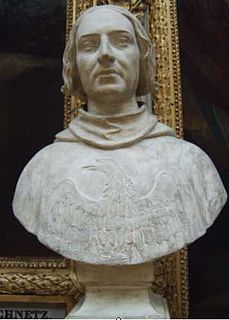 W
WPope Boniface IX was head of the Catholic Church and ruler of the Papal States from 2 November 1389 to his death. He was the second Roman pope of the Western Schism. During this time the Avignon claimants, Clement VII and Benedict XIII, maintained the Roman Curia in Avignon, under the protection of the French monarchy.
 W
WCharles VI, called the Beloved and later the Mad, was King of France for 42 years, from 1380 until his death in 1422. He is known for his mental illness and psychotic episodes which plagued him throughout his life. Charles's reign would see his army crushed at the Battle of Agincourt, leading to the signing of the Treaty of Troyes, which made his future son-in-law Henry V of England his regent and heir to the throne of France. However, Henry would die shortly before Charles, which gave the House of Valois the chance to continue the fight against the English, leading to their eventual victory and the end of the Hundred Years' War in 1453.
 W
WJean de Vienne was a French knight, general and Admiral of France during the Hundred Years' War.
 W
WEnguerrand VII de Coucy,, also known as Ingelram de Coucy and Ingelram de Couci, was a medieval French nobleman, and the last Lord of Coucy. He became son-in-law of King Edward III of England following his marriage to the king's daughter, Isabella of England, and the couple was subsequently granted by the king several English estates, among them the title Earl of Bedford. Coucy fought in the Battle of Nicopolis (1396) as part of a failed crusade against the Ottoman Empire, and was taken prisoner. Having contracted the bubonic plague, he died in captivity at Bursa, Ottoman Empire.
 W
WJohn the Fearless was a scion of the French royal family who ruled the Burgundian State from 1404 until his death in 1419. He played a key role in French national affairs during the early 15th century, particularly in the struggles to rule the country for the mentally ill King Charles VI, his cousin, and the Hundred Years' War with England. A rash, ruthless and unscrupulous politician, John murdered the King's brother, the Duke of Orléans, in an attempt to gain control of the government, which led to the eruption of the Armagnac–Burgundian Civil War in France and in turn culminated in his own assassination in 1419.
 W
WLouis de Bourbon, called the Good, son of Peter de Bourbon and Isabella de Valois, was the third Duke of Bourbon.
 W
WPhilip of Artois, son of John of Artois, Count of Eu, and Isabeau of Melun, was Count of Eu from 1387 until his death, succeeding his brother Robert.
 W
WJohn Beaufort, 1st Marquess of Somerset and 1st Marquess of Dorset, later only 1st Earl of Somerset, was an English nobleman and politician. He was the first of the four illegitimate children of John of Gaunt (1340-1399) by his mistress Katherine Swynford, whom he later married in 1396. Beaufort's surname probably reflects his birthplace at his father's castle and manor of Beaufort in Champagne, France. The Portcullis heraldic badge of the Beauforts, now the emblem of the House of Commons, is believed to have been based on that of the castle of Beaufort, now demolished.